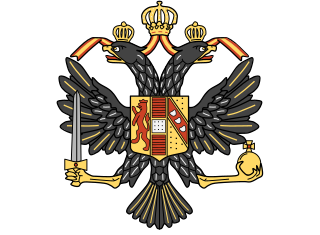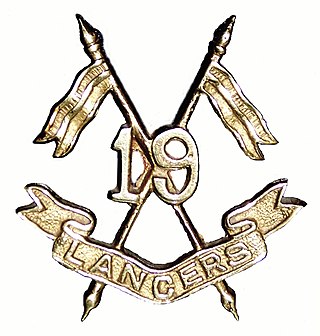
The Queen's Royal Hussars (The Queen's Own and Royal Irish) (QRH) is a British armoured regiment. It was formed on 1 September 1993 from the amalgamation of the Queen's Own Hussars and the Queen's Royal Irish Hussars. The regiment and its antecedents have been awarded 172 Battle Honours and eight Victoria Crosses. The regiment was based in Sennelager, Germany, until 2019 when it was relocated to Tidworth Camp, England. It is the armoured regiment for 20th Armoured Brigade Combat Team.

1st The Queen's Dragoon Guards (QDG) is a regiment in the Royal Armoured Corps of the British Army. Nicknamed The Welsh Cavalry, the regiment recruits from Wales and the bordering English counties of Cheshire, Herefordshire, and Shropshire, and is the senior cavalry regiment, and therefore senior regiment of the line of the British Army.

The Battle of Chawinda was a major engagement between Pakistan and India in the Second Kashmir War as part of the Sialkot campaign. It is well known as being one of the largest tank battles in history since the Battle of Kursk, which was fought between the Soviet Union and Nazi Germany in World War II.

45 Cavalry is an armoured regiment in the Armoured Corps of the Indian Army. The regiment distinguished itself in operations during the 1971 Indo-Pakistan War winning one Maha Vir Chakra.
42nd Armoured Regiment is an armoured regiment of the Indian Army Armoured Corps of the Indian Army.

The Guides Cavalry (Frontier Force) is an armoured regiment of the Pakistan Army which was raised in 1846 as The Corps of Guides. During more than a hundred and fifty years of military service, the regiment has earned the reputation of one of the most renowned military units in the world.

The 15th Lancers (Baloch) is an armoured regiment of the Pakistan Army. It was formed in 1922 by the amalgamation of the 17th Cavalry and the 37th Lancers (Baluch Horse).

The 19th Lancers is an armoured regiment of the Pakistan Army. Before 1956, it was known as 19th King George V's Own Lancers, which was a regular cavalry regiment of the British Indian Army. It was formed in 1922, by the amalgamation of 18th King George's Own Lancers and 19th Lancers (Fane's Horse). On Partition of India in 1947, the regiment was allotted to Pakistan.

The 20th Lancers is an armoured regiment in the Armoured Corps of the Pakistan Army. It is considered to be the successor of the old 20th Lancers of the British Indian Army. As part of a reorganization of the British Indian Army, the original 20th Lancers was formed in 1922 by the amalgamation of the 14th Murray's Jat Lancers and the 15th Lancers.

The 13th Lancers is an armoured regiment of Pakistan Army. It was formed in 1923 as 13th Duke of Connaught's Own Lancers by the amalgamation of 31st Duke of Connaught's Own Lancers and 32nd Lancers. On Partition of India in 1947, the regiment was allotted to Pakistan.
90 Armoured Regiment is an armoured regiment of the Indian Army.
63rd Cavalry is an armoured regiment of the Indian Army.
20th Lancers is an armoured regiment in the Armoured Corps of the Indian Army. The regiment distinguished itself in operations with its defence of Chhamb in Jammu and Kashmir during the 1965 Indo-Pakistan War and won one Maha Vir Chakra. It has provided one Chief of Army Staff and two Army Commanders.
The 64th Cavalry is an armoured regiment of the Armoured Corps of the Indian Army.
The 41st Armoured Regiment is part of the Armoured Corps of the Indian Army.
86 Armoured Regiment is an armoured regiment of the Indian Army.
50 Armoured Regiment is an armoured regiment which is part of the Armoured Corps of the Indian Army.
66th Armoured Regiment is an armoured regiment which is part of the Armoured Corps of the Indian Army.

75 Armoured Regiment is an armoured regiment of the Indian Army.

71 Armoured Regiment is an armoured regiment of the Indian Army.










